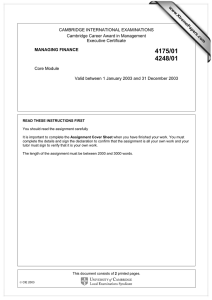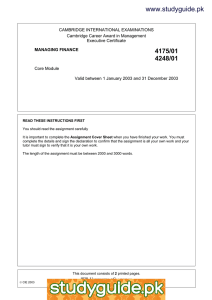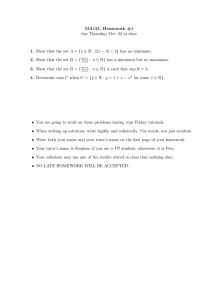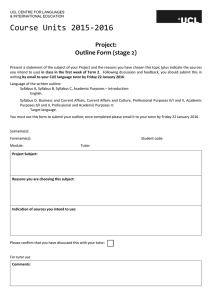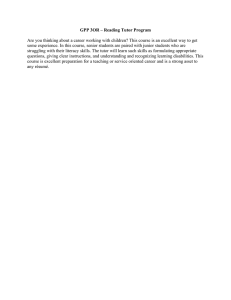www.XtremePapers.com
advertisement
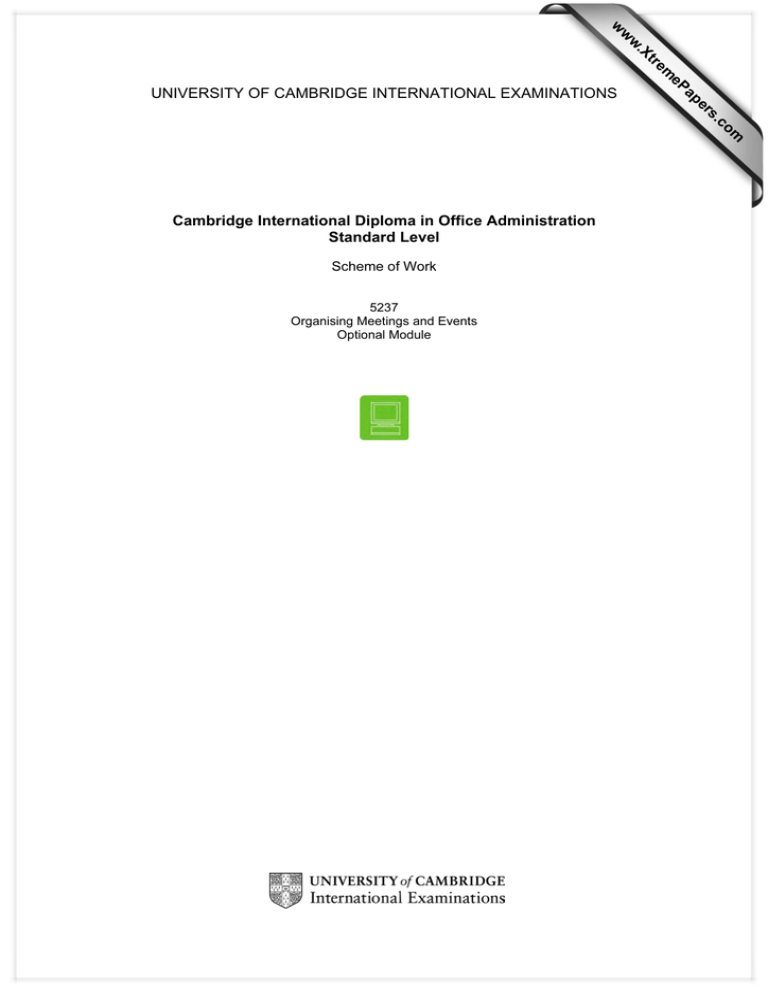
w w ap eP m e tr .X w UNIVERSITY OF CAMBRIDGE INTERNATIONAL EXAMINATIONS om .c s er Cambridge International Diploma in Office Administration Standard Level Scheme of Work 5237 Organising Meetings and Events Optional Module Introduction Organising Meetings and Events is an Optional module and is concerned with the organisation of meetings and events as well as the documentation related to these, and the production of a report. What is assessed in this Module? The organisation of: · a team meeting · a staff meeting · a social club meeting · a sales meeting · a departmental meeting · a students’ union meeting, or · any suitable meeting Production of an individual report Tutor Preparation Required to Deliver this Module You will need: · access to reference books and a variety of resources, including the World Wide Web · access to a wide range of various documents and stationery such as letter-headed paper, memos, etc. · a flipchart, whiteboard or similar, overhead projector, screen and appropriate pens · step-by-step process for organising meetings · a collection of various leaflets, brochures, advertisements etc. · instruction sheets for students undertaking tasks · access to computers (and a laptop and presentations software if possible), and other office equipment, such as photocopiers, fax machines, etc. · to make contact with outside venues regarding possible visits to check suitability for holding meetings and events Underpinning Knowledge · · an ability to display a variety of business documents a good standard of communication – oral and written General Principles and Procedures Most of the students are likely to have some experience of meetings, either at work, at school or in their social lives. They may have attended meetings, or may have taken part in some way. However, some students may have no experience of meetings at all. It is very likely that they will also have different levels of ability as well as skills and experience. Tutors may wish to consider whole class, group and individual activities, as well as a variety of teaching methods. Administrators and secretaries are likely to be called upon to organise a variety of meetings and events during their working career. A great deal depends, of course, on the kind of organisation for which they work. Most businesses hold a number of meetings and events on a regular basis (these may range from small team meetings with perhaps two or three people taking part to large external events involving hundreds of people). Students working for such organisations are likely to have many opportunities to organise meetings and events as part of their job. Those who are © CIE 2002 2 not employed, however, may still be able to organise 'real' meetings, which may be arranged within their training centre or as a result of liaison with local organisations. There are many textbooks available to help students with the organisation of meetings and events. Search engines on the World Wide Web and numerous websites can also be very useful. Continuous assessment of students’ work by the tutor will be essential to ensure understanding of teaching, to facilitate revision sessions when appropriate and to allow students to receive positive feedback on a regular basis. The opportunity to use computers, with presentations and word processing software, e.g. PowerPoint and MS Word or Corel WordPerfect etc., would be very useful for those undertaking this module. Some liaison with other tutors and shared teaching may be of great benefit, e.g. Shorthand (for example: dictation and transcription of a variety of correspondence, agendas etc.), Text Processing (for example: the typing of correspondence, agendas, notices etc.), Office Procedures, Communication and Task Management and Interpersonal Business Skills. It may also be appropriate for students to observe meetings at the training school organised by students undertaking Advanced level Organising Meetings and Events courses; this will be of benefit to these students also. Suggested Introductory Activity Students should be given an in-depth introduction to the module, with an overview of what is required for success at the Standard Level - the organisation of a meeting and the production of a report. It might be advisable to suggest that students consider organising a small meeting for their final Assignment and to point out that the report is limited to between 1,400 and 1,800 words. A good starting point could be for tutors to give students a clear definition of a meeting: An organised assembly for the transaction of business An excellent introduction to this module could be for students to name types of meetings with which they are familiar. The tutor can record the responses on a flipchart or whiteboard. Meetings are likely to vary from country to country but would probably include: small team meetings, staff meetings and larger annual general meetings of companies. Tutors could prepare a list of those in the syllabus to which other types could be added, if appropriate. Tutors could then move on to give a definition of an event: An organised activity at a particular venue Tutors could use a question and answer session (whole class) to elicit from students the types of events which are regularly held locally and nationally. A flipchart or whiteboard (or similar) can again be used to record responses. Events may include carnivals, open days, founders’ days, galas, charity fund-raisers (marathons, etc.) and many other events which are likely to vary from country to country. Tutors may wish to advise students that the word ‘meeting’ can be confusing. For example, in the United Kingdom, a students’ meeting is a meeting of students but an athletics meeting is an event where people partake in various athletics activities. Tutors may also wish to point out that meetings and events can be very small with perhaps only two or three people present and may also be very large indeed, with hundreds of people taking © CIE 2002 3 part. It may be helpful to point out that one major difference between meetings and events is that for meetings, there would be documentation such as a notice of a meeting, with an agenda and minutes of previous meetings. For an event, there may be an invitation but often little other documentation. Once students have become familiar and have understood the differences between meetings and events, they could then be asked to list the methods of communication with which they are familiar. (They will all have communicated with other people, using a variety of methods, such as mobile phone, text message, telephone, fax, email, etc.) Give students (working individually) five minutes to make a list and then ask them to form their own groups in order to agree a list of communication methods. Students may not know each other, so small groups may be preferred to whole class for this exercise. Each group should elect a 'reporter' to read the list to the whole class – tutor to record on flipchart or whiteboard. The students could prepare a full list (using a computer if possible) and, for homework, they could write alongside each communication method one advantage and one disadvantage for each communication method listed. At the next session, the students could use their homework studies for discussion of the advantages and disadvantages of all the communication methods listed. The tutor could then ask the students which of the communication methods they have listed would be appropriate when organising meetings and events - and to use the advantages and disadvantages to explain why those chosen would be suitable. © CIE 2002 4 Scheme of Work Competence Criteria Session One Classroom Ideas · 3.2 · · · · · 2.1 · · · · · © CIE 2002 introduction to the module: include definitions - meeting/event students brainstorm the different types of meeting with which they are familiar tutor records responses tutor gives out prepared list of types of meetings in syllabus question and answer session (whole class) – tutor to ensure all types of events are included – local and national tutor records responses on a flipchart, whiteboard or OHP students (individually) make a list of all the communication methods that they have used or know about (allow five minutes) group discussion (groups of three or four) – compare lists – each group to make a final list whole class discussion – each group to present its findings – record each communication method on flipchart students record the final list, using computers if possible homework: students list one advantage and one disadvantage for each communication method listed Resources · · · · · flipchart, whiteboard, etc. tutor-prepared list of different types of meetings to include those on page 57 of the syllabus OHP and blank OHTs computers and printers photocopier Notes · · 5 examples of types of meetings: - formal: AGM, board meetings, committees, governors, etc. - informal: social club, departmental, managerial, those organised to solve specific problems, etc. - debates, seminars, etc. - include length and complexity of meetings and number of people involved, e.g. short half an hour meeting with perhaps two to three people (e.g. team meeting); large all-day meeting with hundreds of people (e.g. AGM) - examples of types of events: founders’ days, saints’ days, charity fund-raisers, galas, carnivals, open days, marathons, auctions, sales, various local events, etc. - include internal and external events, of various lengths – all week, all day, half a day, etc. communication methods - oral communications: - telephone, mobile phone and faceto-face - written communications: - email, fax, text message, memo, letter, report, notice, agenda, publicity (invitations, advertisements etc.), minutes, etc. Session Two · 2.1 · · 3.1 · · 4.3 © CIE 2002 · review of homework: advantages and disadvantages of communication methods listed in previous session in groups of three or four students discuss the advantages and disadvantages listed and each group produces a list on a sheet of A3 paper which can be displayed on a flipchart (or whiteboard) students discuss the lists produced and decide on a final copy (using computers if possible) for future reference students split into pairs and research the reasons meetings are held – each pair to prepare a presentation using slides or OHTs presentation by each pair followed by whole class discussion - agree a final list for preparation as slides and printed (or OHTs photocopied) for future reference meetings terminology: students to work in pairs (can be same as previous session or different pairs – tutors’ choice) to research the meanings of the terminology used in meetings – for next session · · · · · · · flipcharts, whiteboards, etc. OHP and blank OHTs computers, printers and screen presentations software, e.g. PowerPoint library facilities or similar with variety of reference books for research purposes photocopier tutor-prepared information sheet listing meeting terminology – see syllabus · · · · · 6 tutor ensures all main advantages and disadvantages are included for each communication method all purposes for holding meetings to be included - see syllabus meetings terminology: tutor to split the 16 items listed on page 58 of the syllabus so that each pair of students have approximately two items to research (depending on number of students in class) students must not only know the definition but must be clear as to the meaning - use all possible facilities, including libraries, etc. in the next session, students must be able to explain the terms they have researched Session Three 4.3 · · 1.1 · 4.1,4.2 · · © CIE 2002 from previous session - each pair of students to explain, to the whole class, the terms they have researched students prepare tabulated list, using computers if possible, to keep for reference observation by students of a meeting within their training centre students to be told that they should observe the proceedings, but are to pay particular attention to the chairperson back in the classroom (or for homework) each student to prepare a list of the chairperson’s duties - based on observations · · · computers, printers and screen OHP or presentations software tutors will need to prepare the observation of a meeting well in advance and could seek the cooperation of Advanced Level students (if appropriate) · · · · · 7 each pair of students to explain to the class the terms they have researched – using OHTs (or PowerPoint slides) if possible a 'real life' meeting is preferable and a students’ meeting, or similar, organised by Advanced Level students could perhaps be observed a simulated meeting should only be used if no real life alternative can be observed students should be observing basic skills and professional techniques of the chairperson tutor to note what minutes are being taken during the meeting Session Four 4.2 · · · 3.2 · 4.4 · · © CIE 2002 review of previous session – duties of the chairperson: students to discuss (whole class) the duties of the chairperson, using lists compiled from observations of meeting students to agree final list (with help and advice from tutor to ensure all chairperson’s duties are included) tutor can make list for handout at next session or may wish students to prepare their own list (as part of text processing session perhaps) question and answer session to extract from students the type of meeting they observed in the previous session tutor can then question the students regarding who was doing the note-taking – an opportunity to develop the topic of minutes, meeting notes and precis tutor can show students examples of each type of document, explaining the differences between them etc. (use photocopies, or OHTs or slides, or mixture) · · · · OHP or PowerPoint software computers, printers and screen tutor-prepared samples of minutes, meeting notes and precis, to include all usual headings, correct layout etc. tutor-prepared handout: tabulated list of minutes, meeting notes and precis, detailing when each would be appropriate etc. · · · · 8 list should include brief description of the chairperson’s duties, e.g. - powers - before the meeting - procedures at the meeting - after the meeting - ensure all duties are included (see syllabus) minutes – recording proceedings of a meeting (see syllabus) minutes to include - headings - apologies - minutes of previous meeting - matters arising - correspondence - (various items discussed) - any other business - date and time of next meeting meeting notes – record key points in simple, informal layout – used when all present agree that minutes are not necessary precis – a brief summary, written or oral, recording main points only Session Five 4.4 · 1.1,2.2,4.1 · 4.1 · · · · 2.3 · · 2.2,2.3 · · · © CIE 2002 review of previous session – minutes, meeting notes, precis etc. if possible, tutor to arrange a question and answer session with the Advanced Level students who organised the observed meeting - for the Standard Level students to ask them about planning, monitoring aids, etc. used in the organisation of their meeting students then work in groups of three or four, each group to explore one 'duty' from list of secretary’s duties prepared by tutor each group to select a 'reporter' who should note findings of group groups report back to whole class for discussion on findings students to agree and prepare a list of duties - for future reference documentation secretary would produce for a meeting: students work in pairs to research the documents required for a small meeting, such as a team meeting of three to five people students to prepare a portfolio of documentation to include at least one example of each of those listed on page 57 of the syllabus tutor to be advising and giving feedback to students constantly homework: students prepare a list of monitoring aids and explain how each would be used · · · · · · tutor-prepared questionnaire for students to complete tutor-prepared list of duties of secretaries at meetings good preparation for the question and answer session will be required plus the co-operation of Advanced Level students computers and printers variety of textbooks, reference books, etc. tutor-prepared list of items included in communications and monitoring evidence from syllabus · · · · · · 9 first session – use of questionnaire to ensure students have understood use of minutes, meeting notes and precis from previous session session involving Advanced Level students can also be of great benefit to those students in their course before they undertake their final assignment duties of secretaries at meetings are listed under 'secretary’s role' on page 58 of syllabus each group to research one of the secretary’s duties (e.g. from 'prior to meeting' section) – depending on how many students in class portfolio of communications and monitoring evidence should be compiled to include all documents listed on page 57 of the syllabus – students’ work should be assessed regularly and feedback given students to prepare (for homework) a list of monitoring aids and how they would be used (revision: for assessment by tutor and feedback to students) Session Six 2.2 · 1.1 · 1.2 · 1.1,1.2 · · · · © CIE 2002 homework: tutor takes in lists of monitoring aids from students for assessment and feedback organising meetings and events: revise definitions and examples given in the first session students work in pairs to research the sources of information and services available locally to help in organising a meeting/event students work in groups of four or five, each group to prepare a checklist for use when inspecting venues tutor to help in preparation of an agreed checklist for use by students students to visit two or three venues (if possible), using checklist to inspect venues: what they offer, prices, etc. discussion of findings in next session · · · · · computers, printers and screen blank OHTs and OHP pens presentations software photocopier access to the World Wide Web, directories, reference books, hotel guides, timetables, advertising material for various local suppliers and services (such as possible venues, caterers and suppliers of audio-visual equipment, etc.) 10 · possibly need venue managers' permission - check - venue types - prices - meeting rooms – size, suitability, etc. - catering facilities - equipment - car parking - overnight accommodation, etc. Session Seven 2.2 1.1 2.1 · · · · · · review of previous session – checklists and inspection of venues revision of planning needs - and then consider those suitable for the organisation of an event split the class into two: one group to discuss the communication methods that would be used for the organisation of a meeting and the other to discuss those for an event reporter for each group to give findings to whole class further discussion – whole class to agree list of communication methods suitable for organising meetings and events students prepare list using computers if possible · · · · · computers, printers and screen blank OHTs and OHP pens presentations software photocopier access to the Internet, directories, reference books, hotel guides, timetables, advertising material for various local suppliers and services (such as possible venues, caterers and suppliers of audio-visual equipment, etc.) · · © CIE 2002 11 planning an event (page 56 of syllabus) - each group should consider - the date, time and duration of the event - suitable venue - likely numbers taking part - invitations and other documents required, e.g. maps, etc. - equipment needed, such as microphone, etc. - refreshments or meals etc. - whether a speaker would be needed and ideas as to who this should be - publicity – whether required and, if so, what type would be appropriate useful session to revise how students would communicate with others and step-by-step planning and co-ordination Session Eight 1.1,1.2,2.1,2.2, 2.3,3.2,4.1,4.4 · · students work in groups of four or five – each group to organise and take part in a meeting, the purpose of which should be to solve a specific problem, such as insufficient rest areas for students/employees; improvements to existing catering facilities; setting up a training office; equipment breakdown/replacement, etc. each group of students will need to plan, elect chairperson, secretary, etc., produce documentation, book venue, prepare signs, etc. · · · a variety of monitoring aids and access to computers computers, printers and possibly a laptop and screen access to the World Wide Web, directories, reference books, hotel guides, timetables, advertising material for various local suppliers and services (such as possible venues, caterers and suppliers of audio-visual equipment, etc.) · · · © CIE 2002 12 need to consider: - date, time and venue - duration of meeting - who should take part (e.g. restrict to class only, or consider enabling other students to take part, etc.) - equipment required, e.g. OHP, flipchart, presentations software and laptop/screen, etc. - documentation (notice, agenda and chairperson’s agenda) - book venue/room - distribute documentation - day before meeting: check venue and all arrangements - day of meeting: chairs, signs, spare copies of agendas, check equipment is working, etc. - during meeting: chairperson’s role, secretary’s duties: take minutes, attendance list, etc. - after meeting: clear up, take down signs, put chairs away, draft minutes, chairperson to action this session will act as a ‘rehearsal’ for the organisation of a meeting in the final assessment assignment tutor to give advice and feedback to each group while activity is ongoing Session Nine 1.1,1.2,2.1,2.2 2.3,3.2,4.1,4.4 · · · · Session Ten 1.1,1.2,2.1,2.2 2.3 © CIE 2002 · review of previous session: organisation of a meeting discussion among students of what worked and what did not students to agree what they would do differently next time each group gives a presentation to the whole class on what they organised and how they did it – using visual aids as appropriate discussion of whole class to discover whether they differed in what they organised and how, etc. and what they would do differently next time – gives them the opportunity to learn from each other · · · · · computers, printers and screen blank OHTs and OHP pens presentations software photocopier access to the World Wide Web, directories, reference books, hotel guides, timetables, advertising material for various local suppliers and services (such as possible venues, caterers and suppliers of audio-visual equipment, etc.) · working in same groups of four or five, students work together to produce a report describing how their meeting was planned and executed, the monitoring aids used, whether these were successful, what they would do differently next time, and what communication methods were used (and why those were chosen) · · · · computers, printers and screen blank OHTs and OHP pens presentations software photocopier · · · · 13 this session may take some time to complete but it should be worthwhile as it will give students opportunities to 'try things out' in preparation for the final assignment tutor to give help and support to students tutor must stress that, although the organisation of a meeting can be a group activity, the production of the report in the assessment assignment must be each individual student’s own work tutor may wish to assess these reports for positive feedback to students remind students that copies of written communications and transcripts of telephone and face-toface conversations should be included Session Eleven all · students research and discuss together the meeting which they could organise for their assessment assignment · · · · access to the World Wide Web computers, printers, etc. a range of brochures, catalogues and price lists for local venues access to the World Wide Web, directories, reference books, hotel guides, timetables, advertising material for various local suppliers and services (such as possible venues, caterers and suppliers of audio-visual equipment, etc.) · · · · © CIE 2002 14 shared experience can be very useful: students not only learn from, but can also offer help and support to, each other students should be given time to research the type of meeting they wish to organise those students who are employed may have more opportunities to undertake the assignment than those who are not employed students who do not have so many opportunities because they are not employed can undertake a simulated assignment if it is impossible to organise a real meeting, but should be careful to include all the competence criteria required Session Twelve all · · · © CIE 2002 students (working in pairs) should read the assignment guidelines carefully and plan the meeting they wish to organise a relatively small meeting may be preferred, bearing in mind that a report must be produced, of no more than 1,800 words each student should then discuss possible ideas with the tutor and modify the proposed plan if required · · · photocopied pages of the assignment guidelines so that each student has his/her own copy (pp 61-63 of syllabus) each student should have a copy of the student assessment record (SAR) – to be completed by tutor and student please note that CIE has recently developed an assignment grid for candidates to use in their assignment work. The emphasis of the grid is on self-assessment for the candidate. It contains details of the syllabus, and a section for the candidate to check that their work covers the required elements. These should be made available to candidates prior to submitting their work, to ensure that all requirements are covered in their assignment 15 · · the resources required will largely depend on where the student organises the meeting, for example, those who organise a meeting at work are likely to have a variety of resources available to them but students who are not employed will require access to a full range of resources to ensure that those who are employed do not have unfair advantage this session can be used to ensure that students know exactly what is required but the organisation of the meeting must be the students’ unaided work and a report must be produced by each individual student Session Thirteen 5.1 · assessment assignment: Organise a meeting and produce an individual written report · · · · computers and printers monitoring aids a range of stationery, including letter-headed paper, etc. access to the World Wide Web, directories, reference books, hotel guides, timetables, advertising material for various local suppliers and services (such as possible venues, caterers and suppliers of audiovisual equipment, etc.) · · · © CIE 2002 16 meeting organised by each student should be real if possible, but may be simulated if a real meeting cannot be organised report must include - a clear explanation of the meeting the student has organised - a description of how the meeting was planned and executed, e.g. three weeks before, two weeks before, one week before, on the day of the meeting, during the meeting, after the meeting, etc. - monitoring aids used, e.g. action plan, work schedule, etc., whether or not these were successful and what would be done differently next time - communication methods used - a conclusion on the success of the meeting - copies of documentation should be included such as site inspection form; record of attendance with original signatures; correspondence, e.g. letters, memos, emails; documentation, e.g. notice of meeting and agenda, chairperson’s agenda etc. summaries of telephone and face-toface conversations, etc. - documentation may be included as appendices to the report, if preferred - tutor to remind students that only the report with accompanying documentation is to be submitted to CIE for assessment Note: those students who organise a simulated meeting must include a conclusion on the success of the meeting Resources TITLE Administration: NVQ Level 1 Administration NVQ Level 2 Administration Procedures for Higher Secretarial Diplomas Business Administration for Secretarial Certificates Business for Advanced Secretarial Students Caribbean Office Procedure – for CXC and Similar Examinations (Fourth Edition) Communication at Work Effective Business Communications Merriam-Webster’s Secretarial Handbook Modern Business Administration NVQ Administration Level 2 Office Procedures Secretarial Duties Secretarial Procedures, International Administration Simulated Work Activities The Personal Assistant: Standard Secondary Student’s Manual The Professional Secretary AUTHOR(S) Nicholson Carysforth Jefferson, Sealy PUBLISHER Thomson Learning Heinemann Heinemann DATE 1995 2001 1999 Sutherland, Canwell Carysforth Heinemann 1999 Heinemann 2001 Jardine and Shaw Hodder Headline Group, London 0 340 76365 7 (pb) Taylor Irwin Huth Kogan Page Thorogood Merriam-Webster 2001 1999 1994 Appleby Carysforth, Rawlinson Harrison Harrison Maclay, Harrison FT Prentice Hall Heinemann 1994 2001 Longman Longman Longman 1996 1996 1994 Carysforth Carysforth Heinemann Heinemann 1996 1998 Spencer, Pruss Continuum International Publishing Group 2000 Websites There are many useful websites – some where you can buy resources on-line - and others of publishers etc. detailing what is available, for example – www.amazon.com www.heinemann.co.uk/vocational Search engines are also very good sources of information, for example – www.ask.com www.google.com www.yahoo.com © CIE 2002 17
